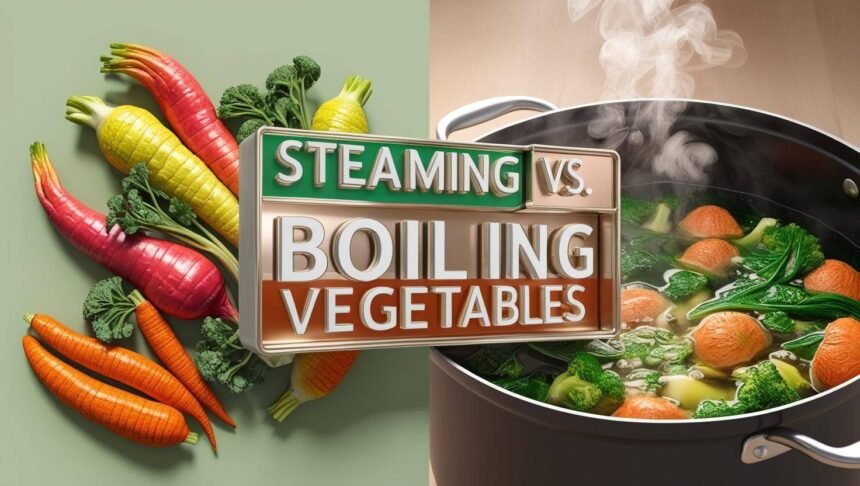There are two main ways to cook greens that people often argue about: steaming and boiling. Both methods have their good points, but they are very different when it comes to taste, structure, and keeping the nutrients.
Knowing these differences can help you make the best choice when you want to get the most health benefits and taste out of your vegetables.
The Nutritional Battle: Steaming vs. Boiling
Why Steaming Preserves More Nutrients
A gentle way to cook, steaming uses hot steam from boiling water to cook food without putting it in liquid.
This method keeps nutrients from being lost as little as possible, especially water-soluble vitamins like vitamin C and phytochemicals like beta-carotene and flavonoid protectors.
Researchers have found that steaming keeps a lot more of these nutrients than boiling does.
A recent study found that, except for carrots, steamed veggies kept more beta-carotene and flavonoids than boiled ones.
After five minutes, cooked vegetables lost only 14.3% to 8.6% of their vitamin C, while boiled vegetables lost a huge 54.6% to 40.4%. Because it keeps the nutrients in the veggies, steaming is a great way to keep their health benefits.
Nutrient Loss in Boiling
When you boil veggies, they are submerged in water, which leaches out nutrients. This effect is made worse by high temperatures and long cooking times, which lower the amounts of important compounds like vitamin C and beta-carotene.
It’s quick and easy to boil, but it loses some of its nutritional value. But boiling vegetables can be helpful for people who like softer textures or need veggies that are easy to chew.
Taste and Texture Considerations
The way you cook your veggies also changes how they taste and feel. Vegetables that have been steamed tend to stay bright, crisp, and delicious, keeping their natural essence. Boiling, on the other hand, can make veggies softer and less flavorful.
One study that looked at steamed and boiled broccoli found that steaming was better for texture, flavor, and general look. But everyone has different tastes.
Some people, like food writer Meera Sodha, like to boil because it’s easy and doesn’t require much attention. This is especially useful when adding vegetables to other recipes, like curries.
Best Practices for Steaming Vegetables
When and how you steam veggies are very important for getting them just right. When you overcook something, it can get too soft, and when you undercook it, it can get too hard. Here are the times that most veggies should be steamed:
- Broccoli florets: 5 minutes
- Cauliflower florets: 5-6 minutes
- Brussels sprouts: 8-10 minutes
- Green beans: 4-5 minutes
- Spinach: 3 minutes
- Peas: 3 minutes
- Small potatoes: 15-20 minutes
- Asparagus: 4-6 minutes
How to Steam Vegetables
Using a collapsible steamer basket is one of the easiest ways to steam vegetables. Here’s a quick guide:
- Fill a pot with 1-2 inches of water and bring it to a boil.
- Place the steamer basket above the water level and add your prepared vegetables.
- Cover with a lid and reduce the heat to medium.
- Steam to your desired tenderness, checking periodically.
How to Enhance the Flavor of Steamed Vegetables?
While steaming prioritizes nutrient retention, some may find its flavors subtle compared to roasting or sautéing. To elevate your steamed vegetables:
- Season with fresh herbs, spices, or a splash of lemon juice.
- Drizzle olive oil or add a tahini dressing for a rich, creamy taste.
- Pair with proteins like grilled chicken, tofu, or fish for a balanced meal.
Simplify Your Vegetable Steaming Hamilton Beach Digital Electric Food Steamer
You might want to buy the Hamilton Beach Digital Electric Food Steamer & Rice Cooker to make steaming vegetables easier. This kitchen tool can be used for many things and is great for quick, healthy cooking. Some important features are:
- Two-Tier Stackable Bowls: Cook multiple foods simultaneously, from vegetables to seafood.
- Generous Capacity: With a 5.5-quart size, it’s ideal for family meals or meal prep.
- Digital Controls: Easy-to-use settings for precise cooking.
- Compact Design: Saves counter space and is easy to store.
This electric steamer makes sure that the veggies are always perfectly cooked, whether you’re steaming broccoli as a side dish or a bunch of vegetables to prepare for a meal later. It works well and is easy to use, so health-conscious home cooks should get one.
Steaming and Boiling: Final Thoughts
You can make healthy vegetable meals by either steaming or boiling them, but steaming is better because it keeps more of the nutrients and makes the food taste better.
Although cooking makes things easier to handle and makes them softer, it can cause a lot of nutrients to be lost. You can find the best cooking method for your tastes and nutritional needs by trying out different ones.
Getting a dependable steamer like the Hamilton Beach Digital Electric Food Steamer can make all the difference for people who care about taste and nutrition.
Remember that the important thing is to enjoy your veggies in a way that makes you want to eat more of them, no matter how you cook them.












